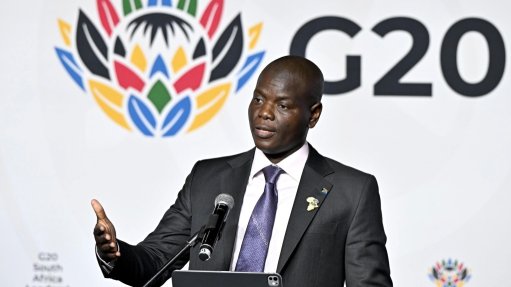Sasol Circuit Team wins race, motorsport used as lab on wheels
The Sasol Racing Circuit Team won last month’s seventh round of the Bridgestone Production Car Championships, which took place at Zwartkops Raceway, in Centurion. Sasol Racing’s Hennie Groenewald claimed the overall honours for the race.
Groenewald had double-points scoring, coupled with a strong opening race, which gave the team a narrow win of 0.085 seconds.
He notes that the Sasol Racing Circuit Team’s WRX STI Subaru underwent eight weeks of exten- sive development, as circuit vehicles have highly sophisticated engines, equipped with technology that can endure extreme conditions yet maintain high performance.
Groenewald notes that Sasol’s contribution to the Sasol Racing Circuit Team is not only as the principal funder but also as the technical and product partner.
“Sasol plays a pivotal role in contributing to the development of racing-engine technology. The result has been high-performance fuels and lubricants that are being developed and tested by Sasol for South African conditions,” says Sasol Oil MD Alan Cameron. Sasol continuously experiments with specialised lubricants to provide specific technical solutions for the Sasol racing team, which will eventually find their way into Sasol’s off-the-shelf products.
Sasol Fuel
“Sasol uses the motorsport platform as a laboratory on wheels to develop and improve products for the general consumer. With this approach, Sasol can safely push the boundaries of performance and endurance and, thereby, ensure that products are fit for purpose for the general consumer,” he explains. The company’s biggest contribution to the team is the Sasol 98 octane unleaded racing fuel, Groenewald states, adding that it is a genuine racing fuel with very fast burning properties and it is batch-blended.
“This means that it is hand-blended, compared with the continuous blending process of Sasol’s refineries and the relatively small volumes of racing fuel blended at Sasol’s research and development (R&D) facilities in Sasolburg, Secunda,” he states.
Groenewald points out that Sasol 98 octane is a direct result of Sasol’s experience with Formula 1 racing and can generally be considered the racing fuel of choice in South Africa.
Further, he notes that Sasol 98 octane uses components from Sasol’s synthetic and crude oil refineries, which are purposely selected to make fuel with improved performance and consistency.
“Sasol also assists the Sasol racing team in improving the Subaru racing engine to where it is compatible with Sasol 98 octane unleaded racing fuel, using its R&D facilities in Muizenberg, Cape Town,” says Groenewald.
The biggest testimony to the positive outcome of Sasol’s laboratory-on-wheels philosophy is the Sasol lubricants.
“The Sasol Subaru racing team currently uses Sasol’s synthetic engine oil, M 5W/40, in the Subaru racing engine – this engine oil was trialled and tested in local motorsport and is available to the general public to be used in their road vehicles,” says Groenewald.
He states that he has been racing the Sasol Subaru for the past three years and became involved with the Sasol Racing team in 2011, when a partnership was formed between racing club SP Racing, Subaru and Sasol.The team consists of a team manager, three technicians, an engine builder and two race car drivers.
“My teammate, Richard Pinard, and I were nominated as the two drivers to compete for the Sasol racing team. At that stage, Richard and I were already contracted by SP Racing from previous seasons, with SP Racing competing in the Wesbank V8 Supercars racing series,” he says. Groenewald points out that Sasol is the team’s principal sponsor and funder and provides the team with the Sasol performance fuels and lubricants used in the racing environment, while Subaru provides the original road car and funding.
“SP Racing is the race engineering team that develops and prepares the race car throughout the season,” he explains.
Subaru STI
The Sasol racing team drives a Subaru STI, which is a four-door, four-wheel-drive saloon car. It uses a four-cylinder, turbocharged engine with a 2 457 cm3 capacity and a power output of 221 KW. “The race car needs to conform to and comply with the road car’s original manufactured homologation, other than the modifications that are allowed and published in our regulations of the series controllers.
“Therefore, most of the basic components must remain standard,” notes Groenewald. He says that examples of the standout modifications that are allowed and fitted to the Subaru are a lowered centre of gravity that assists with better handling and engine control units that are free of restriction.
“SP Racing uses a motorsport-specific unit from advanced engine management and data acquisition systems manufacturer Motec to program the engine to increase performance and reliability.
“This change, including allowances for race-type pistons and valves, enables reliability and increased performance, thereby increasing the power output to 350 KW from the original 221 KW,” Groenewald states. He adds that suspension adjustments are allowed to increase performance when cornering and braking and that the car is fitted with four three-way adjustable shock absorbers from transportation services manufacturer Penske, allowing for the fine-tuning of the suspension for improved handling.
“This includes camber adjustment, which is the vertical angle of the wheel. “Maximum allowable camber is –4˚, which tilts the top of the wheel into the body and is the norm for high-performance cornering,” notes Groenewald. He further explains that a semi- slick race tyre is the only tyre allowed on all cars competing in the race. “The front axle is fitted with four piston-type racing callipers from brake and clutch manufacturer AP, while rear callipers remain standard.
“The brake pads are free of restriction; therefore, the Subaru is fitted with performance friction brake pads, allowing the driver to have better pedal feel and increased performance,” he says, adding that the larger front ventilated discs are fitted within the dimensions of 330 mm. “A racing-specific pedal box is fitted to assist the driver with accuracy and pressure application while braking and a roll cage is compulsory to prevent serious deformation of the bodywork in the event of a collision or rollover.
“The roll cage also assists in chassis rigidity, which is a major factor in the performance of any race car’s efficiency,” he states.
A Motec data logger is fitted to the Subaru, enabling the engineers to download 300 different recorded parameters from the car.
“This enables the team to measure and record information from the race car after it has been on a track. “This system assists the team in identifying trends, problems and improvements, which can then provide valuable knowledge about the performanceand reliability of the engine and chassis,” Groenewald points out.
He adds that exhaust systems are free and that different types, sizes and lengths are continuously tested and developed.
“The Subaru is fitted with an upgraded Kinugawa TD06H-25GXT turbocharger, which provides improved performance during racing conditions,” says Groenewald.
Training
Groenewald states that race car preparation and development for every race is the most important aspect of success on the racetrack.
Typically, after a race, he notes, the team will conduct a debriefing session involving the team manager, engineer, technicians and drivers to evaluate the race, event or test session.
“This provides the team with an opportunity to collectively assess its current performance, the car’s condition and the development and maintenance programme going forward,” he explains.
Groenewald further states that the car is thoroughly cleaned and washed before parts, such as the engine, gearbox, brakes and suspension, are stripped for routine service and maintenance.
“After every race meeting, all engines are subjected to leak-down tests to identify possible engine fatigue or leakage from the cylinder heads. If required, engine rebuilds take place.
“The development parts and items or settings are fitted, engineered, manufactured or adjusted for the next test session or race meeting,” he notes.
Groenewald adds that test sessions are scheduled before the next race meeting, during which the team systematically tests every listed performance variable to improve the car for the next race.
He further notes that parts and adjustments that have proven to be successful in improving performance or reliability become a permanent component or setting for the next race, while those that have not improved peformance will be dis- regarded
“A setup table is used to adjust precise geometry and corner- weight settings to the final setup, which is then recorded for future reference. “A last official test session is held each Friday before the race meeting, where the car is then fine-tuned for race day,” Groenewald concludes.
Article Enquiry
Email Article
Save Article
Feedback
To advertise email advertising@creamermedia.co.za or click here
Comments
Press Office
Announcements
What's On
Subscribe to improve your user experience...
Option 1 (equivalent of R125 a month):
Receive a weekly copy of Creamer Media's Engineering News & Mining Weekly magazine
(print copy for those in South Africa and e-magazine for those outside of South Africa)
Receive daily email newsletters
Access to full search results
Access archive of magazine back copies
Access to Projects in Progress
Access to ONE Research Report of your choice in PDF format
Option 2 (equivalent of R375 a month):
All benefits from Option 1
PLUS
Access to Creamer Media's Research Channel Africa for ALL Research Reports, in PDF format, on various industrial and mining sectors
including Electricity; Water; Energy Transition; Hydrogen; Roads, Rail and Ports; Coal; Gold; Platinum; Battery Metals; etc.
Already a subscriber?
Forgotten your password?
Receive weekly copy of Creamer Media's Engineering News & Mining Weekly magazine (print copy for those in South Africa and e-magazine for those outside of South Africa)
➕
Recieve daily email newsletters
➕
Access to full search results
➕
Access archive of magazine back copies
➕
Access to Projects in Progress
➕
Access to ONE Research Report of your choice in PDF format
RESEARCH CHANNEL AFRICA
R4500 (equivalent of R375 a month)
SUBSCRIBEAll benefits from Option 1
➕
Access to Creamer Media's Research Channel Africa for ALL Research Reports on various industrial and mining sectors, in PDF format, including on:
Electricity
➕
Water
➕
Energy Transition
➕
Hydrogen
➕
Roads, Rail and Ports
➕
Coal
➕
Gold
➕
Platinum
➕
Battery Metals
➕
etc.
Receive all benefits from Option 1 or Option 2 delivered to numerous people at your company
➕
Multiple User names and Passwords for simultaneous log-ins
➕
Intranet integration access to all in your organisation


















